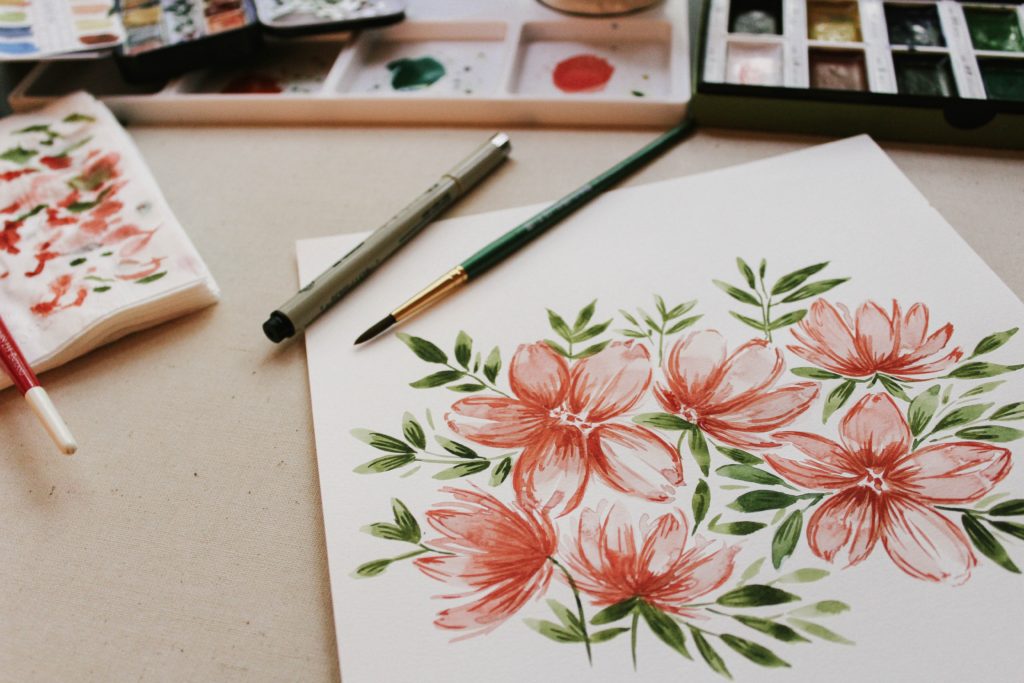Selling art prints online can be challenging when you don’t know where to start.
However, if you wish to run a successful creative business in the modern digital age, it’s essential that you get to grips with the best ways to sell art online.
By 2030 it’s estimated that the majority of purchases will be made via e-commerce.
In fact, in 2017, an astounding 40% of US internet users reported to have purchased items online multiple times each month*.
This shows just how essential your online sales activities will be for your future business success.
Alongside this, it demonstrates that if you want to sell your art, online is a great place to get started.

Where to begin to sell artwork online?
There are several different tactics that you can apply if you want to sell your artwork online.
They include using a range of platforms and sales techniques; however, you need to test each method in order to discover which is the most effective for your particular business or style of artwork.
The main factor in defining this is discovering who your target audience is.
What is considered visually dynamic to one person, may be of no interest to another, so you need to categorise your artwork into target audiences.
When you have done this, you can begin to work out the best places to sell your artwork.
To help you to get started, we have developed this list of the best places to sell your artwork online.
Each part of this list can be applied to the specific target audiences that you have defined as potentially interested in your creations.
Four ways how to sell art online and make money
Create a website for your artwork
Creating an online portfolio for your artwork in the form of a website can provide you with a central hub for your online sales activities.
Furthermore, you can use your website to create a reputable brand image, collate your resources, and start building your rank for essential search terms.
What you need to remember for this channel is that creating a website alone isn’t usually enough to bring in those customers.
You need to advertise your website, create interesting content that web users can enjoy and give them a reason to keep coming back.
The more optimised, advertised and user friendly your site, the more likely you are to attract the right people.
There are so many different ways that you can build an amazing website for customers and potential admirers to enjoy and buy your artwork.
Learn about the best practices for setting up an artist website here!
Referral sites for artwork

Referral sites can be an extremely useful way to drive extra traffic to your website and purchasing pages. There are a lot of different options to choose from too!
A referral site is basically a website that is not your own that can channel customers towards your artwork. They can include any of the following plus many more:
- Etsy
- E-Bay
- Social media pages
- Social media groups
- Local directories
- National directories
- Sector specific directories
- Online publications
- Government websites
- Education websites
- Affiliate websites
A factor that you need to think about when placing your links on referral sites are the domain authority of the site you are placing your link on, as this can affect your page authority if the website who is referring people to you is considered spammy.
You can check the domain authority of a website by using helpful tools like MOZ or SEM Rush or alternatively, you can Google free website domain checkers to find a range of free tools and some simplistic stats for each website.
If the domain authority is less than 40, then it is considered a bad link and may not be worth pursuing.
Another factor to consider is whether the referral site that you are considering using is relevant to your target audience.
After all, there is no point putting a lot of time and effort into setting up a page on another website if the people using that site will not be interested in the products that you offer.
The lesson here is to choose your referral sites with care and not to just post links and build pages for the sake of it – Think quality, not quantity!

Social media for artists
Social media platforms are great, often free, tools that can really extend your reach and help you to gain the attention of a much wider audience relatively easily.
Due to the artwork sector being very visual, social media is also a great way to display your product offering in an engaging way.
Most platforms allow you to upload videos and photos, or even create online galleries.
Tried and tested social media platforms that are great for posting artwork include, but are not limited to, the following:
- Facebook business pages
- Facebook groups
- Youtube
- Google+
All of the above platforms allow the use of hashtags, which can help your desired audience to discover your work faster.
Some sites, like Twitter also have regular networking hours and seasonal hashtags on a variety of subjects that can help you to make an impact.
For example, if you’re an artist in London, you could try #LondonHour to attract some local attention.
Alternatively, if your artwork is all about nature, why not try the hashtag #NatureLovers to attract fellow green fingered folks.
The opportunities really are limitless of social media and the best thing is, as you build your followers, you will be able to keep sharing great pictures, updates and links with them time and time again!
Stock image sites

Stock image sites are really useful for artists who want to make an impact online and see their creations take on a life of their own.
These sites can be useful for both artists and photographers and often pay a small referral fee for each download of your work.
Great stock site options include:
- Pixabay
- Pexels
- Shutterstock
- Flickr
Stock sites can also be useful in gaging how interested web users are in each piece of your work too as most stock image and social media sites provide you with analytics that include how many people have viewed your listings as well as the demographics of those people.
Email campaigning for art sales
Email is an effective way to promote your artwork to a large audience. However, as there are 269 billion marketing emails sent each day*, you need to make sure that what you’re offering can outperform the competition.
Email data that matches your target audience
How effective your email campaigns are can largely depend on the data that you are sending it to.
First of all, you need to make sure that your data is compliant with current legislation, meaning that you can’t just pull email addresses off the internet and start spamming people anymore.
You need to be able to prove “legitimate interest”, which means that the person you are mailing has registered their interest in your product or service offering or sold their details to a data provider who has terms and conditions to back themselves up.
We would recommend sourcing your data from a reputable data provider.
This will be a lot more cost and time effective that putting together a data set yourself and you can avoid potential usage penalties from illegitimate contact.
Purchasing data from a provider can also help you to drill down into particular target audiences that you think will be interested in your products too, as the data company can segregate their lists into age, gender, job role, sector, income and more.
The great thing about it is that if you find that some of the contacts from your list are dead end email addresses, you can usually swap these for better, more engaged email addresses and the data provider won’t mind!
The reason for this is that they want to offer a good service too, so if part of their product isn’t working effectively then they can fulfil a process called “cleansing”.
Data cleansing is simply the removal of bad data, which in turn makes their lists and product offering a lot stronger for yourself and future data users.

Creating engaging emails for your artwork
Finding the best format for your email campaigns will require a lot of A/B testing to begin with.
A/B testing is where you trial one style of email campaign against another to discover which is most effective.
Testing is an essential part of e-campaigning so, prepare to do what you do best and get creative with it to try and capture the attention of your audience.
We suggest that you test different subject lines with the same email body content to begin with.
This will allow you to improve your open rate and get an accurate reflection of the changes that you make.
After you have found some engaging email subject lines that work, it’s time to start testing different email formats.
This could include plain text, full image or a mixture of the two. You need to know what your audience reacts to and what it doesn’t.
As much as there are many things that you can do to attract attention, you have to keep in mind that there are also a few standard rules to follow in order to prevent your emails from getting stuck in sophisticated spam filters and junk files including: not placing a link above the third line of your email, not using spammy phrases such as “save” or “sale” and not using large size images.
Each of the previously mentioned activities will result in your emails getting stuck in spam filters where your potential clients may never see them! – Avoid at all costs!
Instead, choose to provide value, be honest and to not oversell.
If your product is worth having then customers will naturally want to learn more and potentially make a purchase.
Using “You” instead of “we” or “I” makes the entire email about the benefits for the customer, so make sure that you put yourself in their shoes to create content that’s benefit driven and can drive more traffic and sales to your website.
Keep trialling and testing different styles until you find the option with the highest engagement rates, then, after a few weeks, go back, review and adapt your emails to keep creating positive change and try and get those engagement stats through the roof!
Successfully sell artwork online
As you can see, you have a plethora of options to try and test so that you can sell your artwork online.
The most important thing is that you do your research, adapt your strategy and overcome any obstacles that may get in your way.
By ensuring that you regularly review the engagement statistics for each method that you use and take action to improve your content on your findings, you are almost certain to see more customers, more web traffic and more sales come your way!
These have been our top tips for selling artwork online and making money, we hope you found them useful! Keep creating and trialing and you can’t go far wrong!



